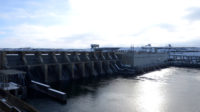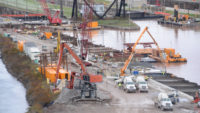Environment
Washington Dam Fish Passage Construction Advances

The preferred plan would allow fish to move downstream through a bypass system.
Image courtesy of U.S. Army Corps of Engineers
A long-planned project to build a fish passage facility on the Howard A. Hanson Dam is advancing with new funding. It would reopen more than 100 miles of western Washington state’s Green River for salmon spawning and rearing.
The Water Resources Development Act, which the U.S. Senate passed this month after lawmakers reached an agreement with their House colleagues, authorizes $878.5 million for the dam project. As ENR previously reported, WRDA includes $37 billion in federal funds for various U.S. Army Corps of Engineers projects.
The Corps’ preferred plan, outlined in an April 2022 report, calls for construction of a fixed multiport collector with steep slope bypass that would allow juvenile fish to move downstream—the least-cost design option with the highest likelihood of meeting survival criteria, according to the Corps.
Corps officials say they expect construction to begin in 2027 and complete in 2030.
Five horn-shaped ports at fixed elevations would collect fish at multiple depths. Each intake port would be capable of withdrawing water at a rate ranging from 230 cu ft per second to 600 cu ft per second. Up to two ports could be used at once, allowing a total withdrawal of up to 1,200 cu ft per second of water. Once collected at the intake ports, fish would travel downstream through steep slope bypass pipes and a deceleration tunnel, then be released into the lower river, most likely through the dam’s left abutment, though the Corps report notes the final design could run the pipe further downstream.
The Green River is a tributary of the Puget Sound, running from the Cascade Mountains to Elliott Bay. Fish access to the upper watershed has been blocked since construction of a diversion dam that was built in 1913 downstream from the later Hanson Dam, which was built without a fish passage as a result.
The Hanson Dam is an earth-and-rock-fill embankment 675 ft long including its spillway and abutment structures. It is 235 ft tall and 960 ft thick at its base. The Corps has conducted several projects on it since it was originally completed in the 1960s.
State and federal officials have identified the Green River Chinook salmon population as a high priority. Experts say the fish is a “keystone” species which would have widespread ecosystem benefits as its population is restored, including for orca. The fish passage facility was first planned in the 1990s. Congress authorized the project in 1999. An upstream trap and haul facility was completed at the lower diversion dam in 2005. Once the fish passage is built, adult salmon would be trucked from the diversion dam to someplace upstream from the Hanson Dam.
For the fish passage, a cofferdam was installed and a 60-ft-wide, 180-ft-long, 100-ft-deep area was excavated, but Corps officials realized they likely faced insufficient funding and suspended construction of the fish passage in 2011. Congress had initially authorized $75.6 million in 1998 prices for the project. The cost estimate with design modifications in October 2021 prices was $855.2 million, and it is now estimated at $921.6 million, including nonfederal funds.
Money from the WRDS funding still must be appropriated to the projects. Earlier this year, the Corps allocated $220 million from the Infrastructure Investment and Jobs Act to the project.
The project is expected to have flood control and drinking water supply benefits as well.
“Not only will this money make an important difference as we work to recover our iconic salmon runs and honor our tribal treaty obligations, it will help get clean drinking water to people across Puget Sound and help protect the region from flooding,” Sen. Patty Murray (D-Wash.) said in a statement.




